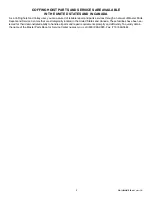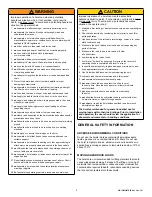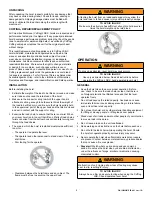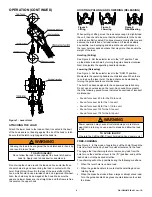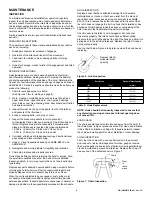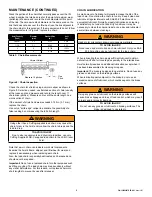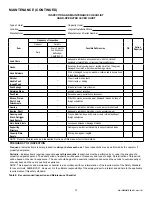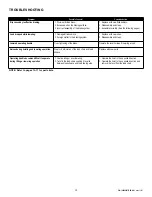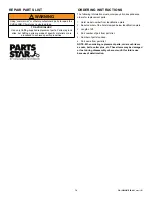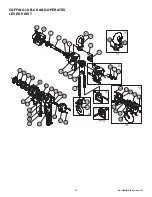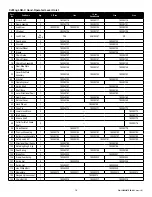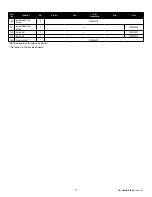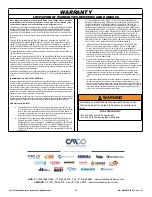
3
P/N: 192090087 REV. AA
October 2021
!
WARNING
Improper operation of a hoist can create a potentially
hazardous situation which, if not avoided, could result in
death, or serious injury
. To avoid such a potentially hazardous
situation, the operator shall:
1.
not
operate a malfunctioning or unusually performing hoist.
2.
not
operate the hoist until you have thoroughly read and
understood this manual.
3.
not
operate a hoist which has been modified without the
manufacturer’s approval or certification to be in conformity with
applicable OSHA regulations.
4.
not
lift or pull more than rated load for the hoist.
5.
not
use damaged hoist or hoist that is not working properly.
6.
not
use hoist with twisted, kinked, damaged,
or worn load chain.
7.
not
operate with any lever extension (cheater bar).
8.
not
attempt to “free chain” the hoist while a load is applied.
9.
not
use the hoist to lift, support, or transport people.
10.
not
lift loads over people and make sure all personnel remain
clear of supported load.
11.
not
attempt to lengthen the load chain or repair damaged load
chain.
12.
Protect the hoist’s load chain from weld splatter or other
damaging contaminants.
13.
not
operate a hoist when it is restricted from forming a straight
line from hook to hook in the direction of loading.
14.
not
use load chain as a sling or wrap load chain around load.
15.
not
apply the load to the tip of the hook or to the hook latch.
16.
not
apply load unless load chain is properly seated in the chain
wheel(s) or sprocket(s).
17.
not
apply load if bearing prevents equal loading on all load-
supporting chains.
18.
not
operate beyond the limits of the load chain travel.
19.
not
leave load supported by the hoist unattended unless specific
precautions have been taken.
20.
not
allow the chain or hook to be used as an electrical or welding
ground.
21.
not
allow the chain or hook to be touched by a live welding
electrode.
22.
not
remove or obscure the warnings on the hoist.
23.
not
operate a hoist that has not been securely attached to a
suitable support.
24.
not
operate a hoist unless load slings or other approved single
attachments are properly sized and seated in the hook saddle.
25.
not
lift loads that are not balanced and the holding action is not
secure, taking up slack carefully.
26.
not
operate a hoist unless all persons are and remain clear of the
supported load.
27.
Report malfunctions or unusual performances of a hoist. Shut it
down and forbid its use until it has undergone repair.
28.
not
operate a hoist on which the safety placards or decals are
missing or illegible.
29.
Be familiar with operating controls, procedures and warnings.
!
CAUTION
improper operation of a hoist can create a potentially
hazardous situation which, if not avoided, could result in
minor
or moderate
injury. To avoid such a potentially hazardous
situation, the operator shall:
1. Maintain a firm footing or be otherwise secured when operating the
hoist.
2. Check brake function by tensioning the hoist prior to each lift or
pulling operation.
3. Use hook latches. Use latches to retain slings, chains, etc., under
slack conditions only.
4.
Make sure the hook latches are closed and not supporting any
parts of the load.
5. Make sure the load is free to move and will clear
all obstructions.
6. Avoid swinging the load or hook.
7. Avoid lever “fly-back” by keeping a firm grip on the lever until
operating stroke is completed and lever is at rest.
8.
Inspect the hoist regularly, replace damaged or worn parts, and
keep appropriate records of maintenance.
9.
Use Columbus McKinnon parts when repairing the unit.
10.
Lubricate load chain as recommended in this manual.
11.
not
operate hoist except with manual power.
12.
not
permit more than one operator to pull on lever at
the same time. More than one operator is likely to indicate
hoist overload.
13.
not
allow your attention to be diverted from operating
the hoist.
14.
not
allow the hoist to be subjected to sharp contact with other
hoists, structures, or objects through misuse.
15.
not
adjust or repair the hoist unless qualified to perform such
adjustments or repairs.
The hoists are intended for general industrial use for
moving loads within their load ratings. Prior to installation
and operation, the user should review the application for
abnormal environmental or handling conditions.
GENERAL SAFETY INFORMATION
ADVERSE ENVIRONMENTAL CONDITIONS
Do not use the hoists in areas containing flammable vapors,
liquids, gasses or any combustible dust or fibers. Do not use
the hoist in highly corrosive, abrasive, wet environments or in
applications involving exposure to temperatures below -10ºF or
above 130ºF.
MOVING HAZARDOUS LOADS
The hoists are not recommended for lifting materials that could
cause widespread damage if dropped. The lifting or moving of
materials that could explode or cause chemical or radioactive
contamination requires fail-safe, redundant supporting devices
that are not incorporated into these hoists.


